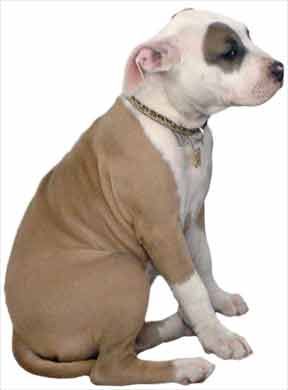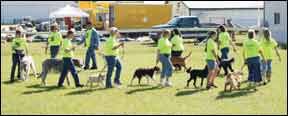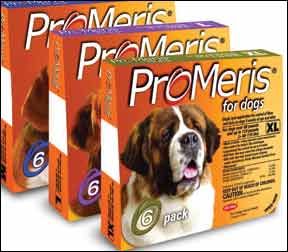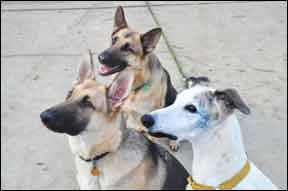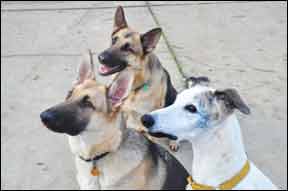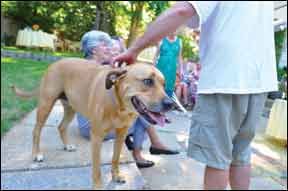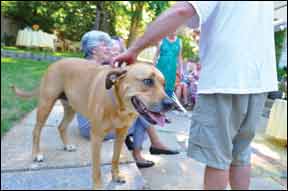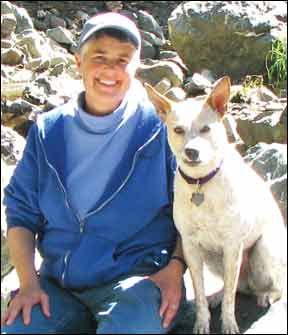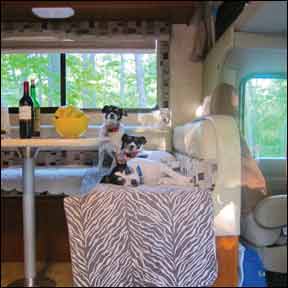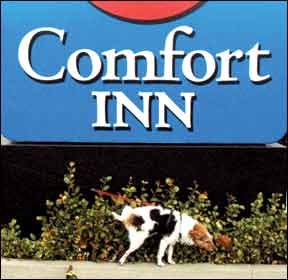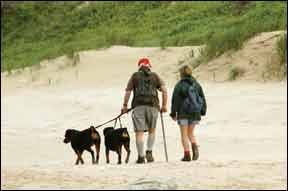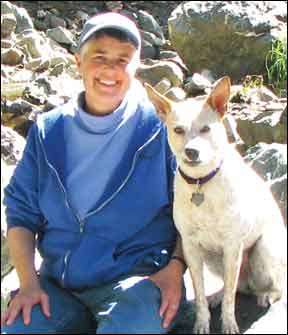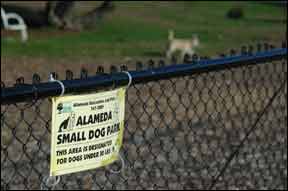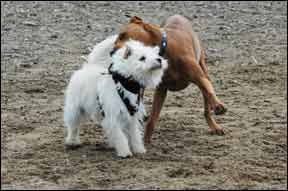Download the Full July 2011 Issue PDF
New Recommendation for Fear-Based Behavior Problems
In May, I attended a seminar given by noted veterinary behaviorist Nicholas Dodman, section head and program director of the Animal Behavior Department of Clinical Sciences at the Tufts University Cummings School of Veterinary Medicine. The seminar, “The Well Adjusted Dog: Secrets to Understanding Canine Behavior,” covered a number of behavior problems, including aggression, separation anxiety, phobias, post-traumatic stress disorder, and canine compulsive behavior. I was most interested in his recommendations for dogs with sound sensitivities, having had a dog whose severe noise phobias eventually degenerated into generalized anxiety disorder, from which she never really recovered (see “Chill Pills,” Whole Dog Journal July 2006).
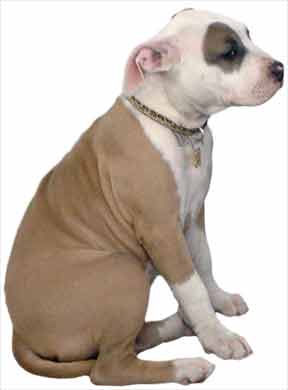
One of the important things I learned is that Dr. Dodman now recommends clonidine instead of alprazolam (Xanax) when quick-acting help is needed for dogs with storm and other noise phobias. He prefers clonidine due to the high frequency of paradoxical excitement he sees in dogs treated with alprazolam, and because it is non-addictive, unlike alprazolam. He calls clonidine his “new favorite secret weapon” for treating storm phobias and other fear-based behavior problems, including separation anxiety and fear aggression.
Clonidine is an alpha-2 agonist; “agonist” is the opposite of “antagonist,” meaning it mimics or increases the effects. Used to treat high blood pressure in humans, clonidine acts in the central nervous system to inhibit the release of norepinephrine (related to adrenaline), a modulator of the “fight or flight” response. According to Dr. Dodman, this drug has few side effects, with sedation being the most common. Because of its effects on blood pressure, it should not be used for dogs with severe cardiovascular or renal disease.
Clonidine can be combined with other drugs used for treating fear and anxiety, including selective serotonin reuptake inhibitors (SSRIs), such as fluoxetine (Prozac, Reconcile), and tricyclic antidepressants (TCAs), such as clomipramine (Clomicalm). Due to the cumulative effect on blood pressure, caution should be used when combining with beta-blockers, digitalis, or calcium channel blockers. Like all of these other drugs, it should not be combined with monoamine oxidase inhibitors (MAOIs), such as selegiline (Anipryl, l-deprenyl) and amitraz (Mitaban, also used in Preventic collars).
Clonidine is a short-acting drug, and so is best used for dogs who need only occasional relief, or combined with other longer-acting drugs, such as Prozac or Clomicalm, as needed for additional effectiveness in treating separation anxiety and other fear-based behavior problems. Because of Prozac’s safety margin, Dr. Dodman now prefers a combination of Prozac and clonidine rather than clomipramine and alprazolam for treating fear-based behavior problems.
Dr. Dodman recommended dosages up to 0.05 mg/kg clonidine (about 1 mg for a 40-pound dog) as needed or twice a day, but would start with 0.01 to 0.02 mg/kg and increase as needed. The drug takes effect in about half an hour, and lasts for three to four hours. If used long-term, it should be weaned off to avoid a spike in blood pressure.
Dr. Dodman also uses melatonin for storm phobias. He says he gives the standard human dosage, 3 milligrams, to dogs weighing 40 to 60 pounds, but will increase that amount to 6 or even 9 milligrams as needed. Melatonin is a hormone that is very safe to use; he said you couldn’t poison a dog with melatonin if you tried. It can be combined with other behavior-modifying drugs as needed.
Medications can provide the help that is needed for behavior modification therapy to work. Behavior problems respond better and more quickly when treated with a combination of behavior modification and drug therapy. For those who need more help, Tufts offers remote behavioral consultations through its PETFAX and VETFAX services.
I wish I started drug therapy for my dog earlier and more aggressively; it might have prevented her phobic behavior from escalating until it ruined her life. I encourage anyone whose dog shows increasing fear-based behavior to explore drug therapy. Don’t make the mistake I did of not wanting to “drug” your dog; the right behavior medication can improve quality of life and allow your dog’s natural personality to reemerge.
– Mary Straus
For more information:
Tufts PETFAX and VETFAX Behavior Consultation
(508) 887-4640; tufts.edu/vet/behavior
What Does The Dog Think?
[Updated February 5, 2016]
Today, we look back with horror at the time, not so very long ago in historical perspective, that scientists assured us that nonhuman animals didn’t feel pain. We know now how cruelly wrong that was. Next we were told that the thing that differentiated us from the other animals was that humans made and used tools, and other animals didn’t. Dr. Jane Goodall’s work, among others, proved the error of that position. You can find countless examples of various nonhuman animals using (and even creating) tools on Youtube.com! My favorite video clip is of a crow bending a wire into a loop so he can reach into a long tube to hook the handle of a small container of food so he can pull it up and eat the food (you can see the clip for yourself at tinyurl.com/cyaeep).
Okay, so other animals can make and use tools, but certainly they don’t have “human” emotions. Or maybe they do. In fact, it’s pretty species-centric to even call them “human” emotions when they are simply . . . emotions.
Current research has demonstrated that many species, including our beloved canines, share brain circuitry very similar to the human part of the brain that controls emotion – the amygdala and the periaqueductal grey. While there’s no doubt among most dog lovers that dogs have emotions, this concept is still being discussed in the halls of academia. Some insist that even though animals show emotional behaviors that we can observe, we can’t assume the behaviors mean the animals who display them have emotional feelings. (I don’t know how anyone can think this, but some scientists really do!) Others, such as the esteemed neurobiologist Dr. Jaak Panskepp of Washington State University, argue that if it walks like a duck and quacks like a duck – it’s probably a duck!
Given that most of us now accept that many animals in addition to humans have at least some emotional capacity, the last stronghold of science is the vast superiority of human cognition: the ability to think.
There was a time when our species believed that dogs (and other nonhuman animals) possessed very little cognitive potential compared to our own large front-brain ability to ponder the mysteries of the universe. It was believed that the size of the cortex controlled cognitive potential, and since a dog’s cortex is relatively smaller than a human’s, they must possess very little real ability to “think.”
Recent studies, however, have demonstrated that even insects, with their tiny brains, are capable or more complex thought than they’ve ever been given credit for.
Getting Up to Date
According to a growing number of studies, most notable those done by Lars Chittka, Professor of Sensory and Behavioural Ecology at Queen Mary’s Research Centre for Psychology and University of Cambridge colleague Jeremy Niven, some insects can count, categorize objects, even recognize human faces – all with brains the size of pinheads. Instead of contributing to intelligence, big brains might just help support bigger bodies, which have larger muscles to coordinate and more sensory information coming in via the larger body surface.
Only in the past decade has the domestic dog begun to be accepted as a study subject for behavioral research. Brian Hare, assistant professor of evolutionary anthropology at Duke University, opened the Duke Canine Cognition Center in the fall of 2009, the same year Marc Hauser, a cognitive psychologist at Harvard University, opened his own such research lab. Similar facilities are now operating across the U.S. and in Europe.
The results are challenging our past beliefs about canine cognitive abilities. Many dog owners have heard of the studies that demonstrate a dog’s ability to follow a pointed finger.
More recently, in a study conducted by John W. Pilley and Alliston K. Reid, the accomplishments of Chaser, the Border Collie who learned more than a thousand names of objects have generated excitement in the dog world.
Of even greater interest to cognitive scientists is Chaser’s ability to distinguish between the names of objects and cues. She understands that names refer to objects, regardless of the action she is told to perform in relation to those objects. She was asked to either “nose,” “paw,” or “take” one of three toys in an experiment, and could successfully do so.
Even more astounding was the final piece of this study, which concluded that Chaser (and by extrapolation, other dogs) is capable of inferential reasoning by exclusion. That is, she can learn the name of a new object based on the fact that it is the only novel object in a group of objects whose names are all already known by her. Meanwhile, biologist and animal behaviorist Ken Ramirez is currently engaged in eye-opening research that studies a dog’s ability to imitate (copy) another dog’s behavior.
While growing evidence supports a theory of significant cognitive ability in dogs, the last holdout may be metacognition – the “self-awareness” that some tightly hold to be a uniquely human trait. But just like treasured misbeliefs from prior eras, this, too, may fall.
David Smith, PhD, a comparative psychologist at the University at Buffalo who has conducted extensive studies in animal cognition, says there is growing evidence that animals share functional parallels with human conscious metacognition – that is, they may share humans’ ability to reflect upon, monitor or regulate their own states of mind.
We now find it absurd to have ever believed that other animals don’t feel pain; there may well come a time when we also find it absurd to believe that dogs and other nonhuman animals aren’t self-aware.
Let’s Talk About It
Recently, I had the honor of attending (and speaking at!) the 21st conference of the Professional Animal Behavior Associates (PABA), and the theme of the entire conference was “Exploring the Dog’s Mind.” What a delight!
I walked into the lecture hall at the University of Guelph (Ontario), excited to be speaking among such notables as Dr. Andrew Luescher of Purdue University; Dr. Alexandra Horowitz, Barnard College at Columbia University; Dr. Meghan Herron, Ohio State University; Karen Pryor, Karen Pryor Clickertraining; Kathy Sdao, Bright Spot Dog Training; and omigosh, Dr. Jaak Panskepp! I was in heady company. Plus, I hadn’t attended a conference for some time, and I was eagerly looking forward to this one that was focused on cutting-edge concepts in canine cognition – how dogs think. I was not to be disappointed.
Dr. Andrew Luescher
Board-certified veterinary animal behaviorist and director of the Animal Behavior Clinic at Purdue University, Dr. Andrew Luescher emceed the conference, and spoke on “The Psychological Needs of Dogs,” and “Companion Animal Welfare.” Dr. Luescher addressed the now well-known importance of early development, and stressed that “Deficiencies or abnormalities in early development can often not be compensated for, and that behavior/temperament issues based on early deficient development have a poor prognosis.”
While we all know of success stories from people who have rescued and rehabilitated dogs who were either undersocialized or traumatized during their early developmental periods, the greater likelihood is that pups who don’t have the opportunity to develop normally during this period will never be completely normal.
Luescher reminded us that part of proper early development requires puppy-proofing and management. While old-fashioned trainers still assert that a dog has to learn that there are consequences for mistakes in order to be fully trained, Luescher refutes this, saying, “The idea that a puppy has to do the wrong thing to learn what the right thing is, is wrong.” His behaviorally scientific explanation for this is, “If a behavior is successful, others are suppressed.” In other words, if a pup is reinforced for doing desirable behaviors, the undesirable ones don’t happen.
In addressing companion animal welfare, Luescher focused on the unsound practice of always breeding for “more.” We have a tendency in our show ring/breeding culture to always exaggerate characteristics. If a breed is big, make it bigger; if it’s small, breed for smaller. If a nose is long, make it longer; if it’s short, make it shorter.
The fallacy of this approach is that it breeds unsoundnesses into our dogs, such that Bulldogs can’t breathe well; the giant breeds have very short lifespans; and many toy breeds can’t whelp without a Caesarian section.
Dr. Meghan Herron
Board Certified Veterinary Animal Behaviorist Meghan Herron, DVM, head clinician at the Behavioral Medicine Clinic at the Ohio State University College of Veterinary Medicine, spoke about her research project on the effects of confrontational training methods on dogs.
Since we are always alert for scientific verification of our assertions that positive training methods are better, and documented statistically significant studies on training methods are rare, Herron’s study is important for dogs and the people who love them. Notable conclusions from her study included:
-Confrontational techniques increase the likelihood of aggression, especially in dogs
-Few dogs respond aggressively to reward-based training
Herron acknowledges that her study had some limitations (as do all studies): it was a “self-selected” sample of dogs presented at the clinic for behavior problems; the study utilized a limited list of potential behavior interventions; it was a self-reporting study, relying on owner-interpretation of behavior; and it did not study the efficiency of various behavior interventions, only the uses and outcomes.
Herron is planning a future study that will utilize a larger sample size; assess a more general population and a wider variety of methods; conduct a stricter comparison between positive reinforcement and positive punishment; and design a prospective study that follows the behavior of the study-group dogs into the future.
Kathy Sdao
The dynamic speaking style of well-known and highly respected applied animal behaviorist Kathy Sdao, MA, ACAAB, puts her in great demand as a seminar presenter. Early in her career, Sdao trained marine mammals at a research laboratory at the University of Hawaii for the U.S. Navy. Now based in Tacoma, Washington, she’s been training dogs and their people since 1995.
Sdao addressed the often-raised question as to whether old-fashioned coercion training is faster than clicker training. Sdao confirmed that if two trainers were in a contest to see which one could get an untrained dog to place his body flat on the ground faster, the trainer using force would likely win. She also confirmed what any experienced clicker trainer knows: that more valuable long-term goals are without a doubt better served by clicker training than by the use of force and coercion. What sort of goals? Simple and clear communication; motivating the dog to act, interact, and engage with humans; building a relationship of trust between dog and human; and creating an accelerated learning process.
Sdao also presented a session on “Hierarchy Malarkey,” refuting the unfortunate “conventional dominance wisdom” that lingers in the minds of the dog-owning public despite the best efforts of positive trainers and behavior consultants worldwide. (In fact, “anti-dominance theory” was an ongoing thread throughout the conference.)
Sdao presented a slightly different perspective by arguing that even the “Nothing In Life Is Free” protocol promoted by many positive trainers – in which a dog has to earn all good stuff by offering a good manners behavior (such as a sit) first – is based in outdated “alpha” theory. Life with dogs isn’t all about who is trying to overthrow the pack leader. Sdao suggests that this perspective needs to be replaced by an approach that embraces cooperation and affection.
Dr. Alexandra Horowitz
Alexandra Horowitz, MS, PhD, is an assistant professor at Barnard College in New York. She has specialized in animal cognition, and has conducted more than 10 years of research on dogs. We anticipate that her current research and studies will provide much needed and credible information for those of us who insist that anthropomorphism is no longer a dirty word.
Anthropomorphism is the use of human characteristics to describe nonhuman animals. According to a 2008 survey of 337 dog owners, most owners believe that their dogs feel sadness, joy, surprise, and fear. There was less of a consensus on other “secondary” emotions that some attributed to their dogs:
-Embarrassment 30%
-Shame 51%
-Disgust 34%
-Guilt 74%
-Empathy 64%
-Pride 58%
-Grief 49%
-Jealousy/fairness 81%
Most dog training and behavior professionals agree that the behavior owners commonly describe as “guilt” is actually simply appeasement behavior offered in response to human body language. Horowitz designed a study to test the guilty look phenomenon, by having the owner leave her dog in the room with a piece of food, after telling the dog not to eat it. Sometimes Horowitz left the food in view, sometimes the dog ate it and sometimes not, and sometimes she removed it and told the owner the dog ate it. If the food was gone, the owner scolded the dog. Horowitz’s findings were:
1) Guilt did not change the rate of the guilty look. The rate of measured “guilty” behaviors was similar whether the dog was “guilty” (ate the treat) or “not guilty” (didn’t eat the treat).
2) Owner behavior did change the rate of the guilty look. The rate of guilty behavior was significantly higher when the dog was scolded than when the dog was greeted, regardless of whether or not it had eaten the treat.
3) Dogs showed the most guilty behavior when they were “not guilty” but punished. Scolding led to higher rates of guilty look behavior when the dog had not eaten the treat than when the dog had eaten it.
It’s always nice when we have science to back up some of our dearly held training and behavior beliefs, like the one that says “dogs are offering appeasement behaviors, not showing guilt, when their owners come home to a soiled carpet or overturned garbage can.” Horowitz’s current and ongoing study on whether dogs perceive “fairness” is likely to have equally interesting results.
Horowitz’s second intriguing presentation was entitled “What Is It Like to Be a Dog?” She reminded us that because of dogs’ incredible sense of smell, their world arrives on the air, and they tell time differently than we do. If the wind is right, they can smell the future – that which is in front of them that they will soon encounter. When they are smelling the ground, or the neighborhood pee-post, they are actually smelling the past – that which has come here before.
For more on her perspectives on how dogs perceive the world, you can read Dr. Horowitz’s fascinating book, Inside of a Dog; What Dogs See, Smell and Know, published in 2009.
Karen Pryor
A behavioral biologist with an international reputation in the fields of marine mammal biology and behavioral psychology – as well as one of the founders of clicker training – Karen Pryor spoke on “creativity and the animal mind.”
According to Pryor, being creative implies novelty: producing something new and different. She referenced Dr. Jaak Panskepp’s work with the seeking system – that which motivates an animal to go out and have fun. Seeking behavior is not driven by survival; it happens only when the animal is already comfortable.
In humans, seeking includes things like window-shopping, doing puzzles and playing games, and Web surfing. In nonhuman animals, seeking may include exploring new terrain and showing curiosity about new objects and other living things.
Pryor suggests dog training can capitalize on seeking and creativity by clicking and treating exploration, chance-taking, persistence, and novel behavior. Because your dog can’t be wrong (you’ve not asked for a behavior) there’s no association with failure, so the dog has fun. The more behaviors you capture or shape, the more innovations your dog is capable of inventing. The well-known “101 things to do with a prop” is a great example of asking your dog to innovate.
Dr. Jaak Panskepp
Jaak Panskepp, PhD, is the Baily Endowed Chair of Animal Well-Being Science for the department of Veterinary and Comparative Anatomy, Pharmacology, and Physiology at Washington State University’s College of Veterinary Medicine, and Emeritus Professor of the department of Psychology at Bowling Green State University.
Dr. Panskepp has been described as being 20 years ahead of his time. His work on animal emotions and the brain’s “seeking system” – fueled by the neurotransmitter dopamine, which promotes states of eagerness and directed purpose – takes behavior science to the cutting edge. Panskepp describes the seeking system as, “the mammalian motivational engine that each day gets us out of the bed, or den, or hole to venture forth into the world.”
Panskepp argues convincingly that not only do nonhuman animals possess emotions, but they also possess what behavioral science calls “mind.” In refuting the “lack of proof” argument in the “do dogs have emotions?” discussion, he asserts that scientists deal with “weight of evidence,” not “proof.” The weight of evidence overwhelmingly indicates that animals have feelings. In fact, the evidence is so strong that animals have emotional feelings (not just emotional behaviors), that he says it’s a done deal, case closed (although the argument still rages in academic circles).
The question of “mind,” or metacognition, may be more open to debate. Mind has three fundamental properties:
Subjectivity – Experiences “self” in the real world.
Volition – Deliberate behavior; intentionality, seeking, desire, interest, and expectancy.
Consciousness – The capacity for self- consciousness, includes questions about “theory of mind” in nonhuman animals; whether animals are capable of attributing mental states to others.
Hard scientific evidence of canine mind is harder to come by than canine emotion. The same brain circuits exist in humans and many other animals, suggesting that mind may exist for them. Panskepp argues that animals do possess at least some degree of mind, and that the answer to this question will become clearer with continued neurobiological and cognitive study. Indeed, some aspects of canine mind seem inarguable. Does anyone doubt that dogs have volition? If it walks like a duck . . .
Pat Miller
I also spoke at the conference, on two topics dear to my heart: shelter assessments and modifying dog-dog reactivity. I presented video and an applied science discussion from my work in these areas (citing Kelley Bollen’s 2007 study on shelter assessments).
Mostly I watched, listened, and marveled at the depth and breadth of information offered at the conference, and at the evidence of how far we have come in the world of dog training and behavior. Not so long ago, few, if any, dog trainers had a clue about the science of behavior and learning, nor a working knowledge of operant and classical conditioning, theory of mind, metacognition, creativity, shaping, or any of the other concepts presented at this conference.
We may still have much to learn about what our dogs are thinking, but we have come a long, long way from those dark days when animals supposedly didn’t feel pain.
Pat Miller, CBCC-KA, CPDT-KA, CDBC, is WDJ’s Training Editor. She lives in Fairplay, Maryland, site of her Peaceable Paws training center, where she offers dog training classes and courses for trainers.
K9 Drill and Demo Teams
What brings together heelwork, tricks, music, a little high school nostalgia, and takes it all to a whole new level? K9 drill, display, and demonstration teams are not new, but as more of us are looking for different ways to showcase the rewards of positive training to the larger dog community, the concept of drill and demo teams is gathering steam.
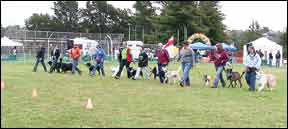
Photo courtesy of Karen Hilker.
288
The term “drill team” may evoke images of military marching routines (historically, military drill teams did occasionally include dogs), but today’s K9 drill and demo teams take many forms that involve dog/handler pairs. “I define it as a group of dog/handler teams, moving in unison to create a changing picture of shapes and lines, with or without music,” says Doris Herber, a retired dog trainer and behavior consultant who participated for several years in a drill team with her Basenji, Kodi.
Herber, who has had a lifelong love for dogs and a fascination with the roles dogs play in our lives, says K9 drill team has been one of her favorite activities. Herber is a pioneer in the small community of K9 drill teams, helping others learn about and participate in this activity through her articles and creating the K9 drill team Yahoo group.
While a K9 drill team is about moving together in patterns, Herber says drill work is not bound by the rules and restrictions imposed upon many dog-related activities. She describes it as very “open” and says that the process of developing routines lends itself to creativity.
The choreographed patterns of drill routines are often similar to marching band geometric formations, but they can be more akin to a square dance or line dance as well. Handlers may move through the routines with meticulous precision or with a more footloose style. Dogs move alongside their handlers heeling on the left or right side, but may also perform other movements such as pivots, turns, sits, downs, call to front, or return to heel.
These basic actions may be expanded upon with tricks such as dogs backing up, circling handlers, handlers circling dogs, leg weaves, spins – or even theatrics or a little comedy. The great thing about this activity is that it can be anything you and your teammates want it to be.
Participating in a K9 drill and demo team can benefit dogs, handlers, and even the community at large. Drill and demo teams are a great way to:
Showcase the positive. While positive training is not a requirement for a drill or demo team, the routines lend themselves to a positive approach. The demonstrations can be a wonderful way to showcase positive training techniques or bring attention to clubs and training organizations. At demos, people notice and comment on how focused the dogs are, and how even when the members make mistakes (and mistakes will be made!) the dogs look happy. “The connection that develops between handler and dog is amazing,” says Herber, and people take notice.
Build basic skills. The behaviors practiced during drill teamwork – moving together, turns, stops, stays, and more – are applicable in everyday life. Dogs learn to work near other people and dogs and to stay focused in the face of distractions. You will have the opportunity to work around crowds and in various locations. Plus, training with and being responsible to a group provides strong motivation to practice!
Be creative! Coming up with routines, finding music, and working through the kinks can be a very creative process. “The creative exchange of ideas and the problem solving is addictive,” says Herber. Playing with patterns, movements, and putting it all together is as rewarding as participating and showing off during demonstrations.
Build relationships. Working with a group demands that you spend time with your dog. “Drill team work became one of my favorite activities because it involved much one-on-one time with Kodi,” says Herber. “This one-on-one connection is one of the best benefits of the drill team activity.” Participating in a drill and demo team can be a great way to help socialize your dog and help him or her to build successful relationships with others too. The camaraderie of training and working with other like-minded people and their dogs is an added bonus.
Have fun with your dog! “Kodi seemed to enjoy the drill team work as much as I did,” says Herber. “If I started the music, he would come running from wherever he was, look me in the eye with a ‘Let’s go!’ expression.”
Forming a Team
If your interest is piqued and you think you might like to participate in a K9 drill or demo team, look around in your community or explore local dog training clubs. You may find a local drill team that you can join. But as likely as not, participating in a drill and demo team will mean starting one of your own; there just are not that many out there yet.
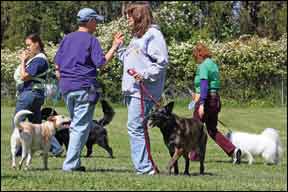
Photo by Laura Nicole Johnson.
288
To get a team started, look for like-minded people – those who love dog training and who want to put in the time and effort it will take to form and perform with a team. The members of the demo team I belong to are all part of a small local positive reinforcement-based training club. You may also find interested team members in training classes, or through friends or neighbors. A drill or demo team can have as few as 2 or as many as 40 dog and handler pairs, but we’ve found that 8 to 10 pairs works especially well.
Once you’ve found a few others to start a team with, set your team goals. Think about the types of routines you’d like to do. Your team may want to experiment as a group to find where your interests and abilities lie. Are you a formal team who would enjoy clean, crisp marching style routines? Or are you more inclined toward musical freestyle or tricks? Or a combination of both?
Your team will also need a place to practice. We meet at a local park, but you might also find space at a training facility or even through a community center. Figure that you will need a minimum of 40 x 60 feet of space, and for a larger group, you may need a little more.
You can start practicing, even before you have developed a routine. Practice basic skills such as:
–Attention. Your dog will need to be able to work with you and stay focused for the length of your routine.
–Heeling or walking together with pace changes, in straight lines and curved lines (perhaps on both sides).
–Transitions from sit to down to stand.
–Clean stops (usually in a standing position).
–Turns – at minimum a right, left, and about turn, but you may want to include flashier turns as well.
–Stay – especially with you walking purposefully away.
–Return to heel or dog circling the handler.
–Handler circling the dog.
These practices will build your skills for routines, and practicing in your group will also help the dogs get to know and trust each other before you work together on routines.
Expect the usual group dynamics in your drill and demo team – with the humans and dogs. For the humans, think about how you communicate with each other and make decisions, and who will lead your practices. Having some structure in place can help when it comes to group work, but plan to be flexible, too. For example, some team members will be able to learn routines in a few sessions; others may need a little more time and help from their teammates.
Consider the dogs’ group dynamics, too. Some of the dogs may immediately work well as part of the group, while others may see their canine teammates as playmates. Some dogs may be comfortable working near certain dogs, but less comfortable with others. Give the dogs time and space, and gently help them learn to trust each other. Even dogs who get along well with other dogs can be uncertain when it comes to “working” within a group of other dogs.
Developing a Routine
Developing a routine is a many step process and may be done by one or more of the team members, or the group as a whole. You might want to spend some time looking at videos of other teams and their routines for ideas.
Herber says that the most important thing to do when working on a routine is to keep it simple. You might be tempted to add in a lot of fancy tricks, but a simple routine that is well done will show better than a more complicated routine that doesn’t quite hold together. Consider using basic formations and transitions for most of the routine, and then pick just one or two flashier moments as focal points.

288
The formations are really the main structure of a routine. They are basically the geometric shapes (like a circle, rectangle, triangle, or diamond) that your team members create. The formations can be made up of single or double lines, crossed lines, arrows, or curved lines. When your team is in a formation, you can move together as a unit, keeping the shape, for example walking in a circle. Or you can remain stationary while having the dogs perform a behavior such as circling the handler or while having the handler perform a behavior such as circling the dogs.
The transitions are what you do to get from one formation to another. These are essential to the flow of the routine. Imagine your team is in a circle formation facing the center, and you want to move into a straight line with everyone facing the audience. You could move by “following the leader” around the circle and into a line, or with half of the team moving in one direction and half in the opposite direction, meeting in the middle. How you put this all together is part of the creative challenge and fun.
When planning a routine, be aware of the skill set and abilities of your handlers and dogs. If your group has varied levels of experience, you will need to consider what all of the team members can reasonably accomplish. Herber says, “We had two greyhounds on our first team. They could not sit well.” They decided to have the greyhounds at each end of the line in a standing position while the other dogs sat. The dogs’ limitations became a design decision!
Build in some flexibility to your routines too. You might end up performing a routine in a smaller space than you expected, or you may have a team member not be able to make a performance because of an illness. “Once we got to a location to perform for a Boy Scout troop and found a large support pole in the middle of the space,” says Herber. “We had to quickly alter our routine to accommodate the pole.”
Your group will also need to decide if you want to use music. Music is not essential, but it can give you a rhythm to work with and it can add polish to a performance. When you choose music, know that it will be something that you will listen to a lot while practicing! Choose something that you and your teammates will enjoy, but that will also be a crowd pleaser. Pick something with a good beat and look for the right tempo for your group. Consider copyright issues too. If you are doing small performances and you are not charging money, you will not likely have an issue, but it’s something to keep in mind.
Once you have thought about the types of patterns, transitions, and movements you’d like to include and you’ve chosen your music, you’re ready to start putting your moves to the music. It can help to listen to the music and walk through different moves to make sure they work together (this might be best done without the dogs!). You may want to diagram your routine (think football diagrams) to help you visualize. Once you get an idea of what you want to do, try it out and adjust as needed.
Practice, Practice . . .
For a polished routine, you will need more practice than you might imagine. You (the human partners) will need to learn your part – where you need to be and when; it’s very much like learning a series of dance steps. Then you’ll need to learn to do it in coordination with your teammates. Spacing, timing, and straight lines will make all the difference in how your routine looks to an audience. It is a great idea to practice this without your dogs first; your learning mistakes could cause confusion for your dogs.
While you’re learning your part, practice individual elements with the dogs, such as moving together in a straight line or a circle. Even a simple routine can be much harder for the dogs than it may seem, so laying a good foundation can really help keep it fun for them.
Once you and the dogs have got your parts down, and your team is working well together, take your practice to new locations. Don’t be surprised if your dogs work differently on grass than they do on pavement, and moving from outdoors to indoors can be a whole new experience. All of you may have a harder time when there is another activity going on right next to where you are practicing or performing, too. At a recent performance, the announcer in the ring next to ours was so loud, that we (the people) had a really hard time with our timing and cuing off of the music. In addition, dogs running lure coursing across the field from our ring gave our dogs an extra distraction. You never know what challenges you might run into, so practicing around all kinds of distractions will help.
The Show on the Road
When you and your teammates are comfortable with your routine, look for places to perform. “Our nameless K9 drill team did performances for training classes, nursing homes, school groups, Boy Scouts, and anyone who would watch,” says Herber. Local dog events, shelter fundraisers, and other community activities are also good venues.
For some members, the performance will be the highlight. It can be fun to show off your dog and entertain a crowd. For others, the actual performance might be a little nerve-wracking. But the payoff at the end can be worth it.
“When everything falls into place and someone comes up to you afterward and says, ‘You gave me goose-bumps and brought tears to my eyes,’ it makes it all worthwhile,” says Herber.
Mardi Richmond is a writer, trainer and a member of the Santa Cruz Dog Training Club’s un-named heelwork and drill demo team. Being part of the demo team is by far her dog Chance’s favorite activity!
Download the Full June 2011 Issue PDF
Join Whole Dog Journal
Already a member?
Click Here to Sign In | Forgot your password? | Activate Web AccessProMeris Discontinued
Pfizer has announced plans to discontinue manufacture and sale of its flea and tick control product, ProMeris. Orders will continue to be filled until September 20, 2011.

288
ProMeris was introduced in the fall of 2007, and touted as the first topical product to use metaflumizone. Pfizer gained control of ProMeris when it acquired Wyeth/Fort Dodge Animal Health in 2009. Pfizer is also the maker of Revolution, used to control fleas and one species of ticks, along with heartworm, ear mites, and sarcoptic mange.
While no specific reasons were given, it’s likely that Pfizer’s decision was influenced by the March publication of a study in the journal Veterinary Dermatology that was done at North Carolina State University. The study concluded that ProMeris “has the potential of triggering a variant of PF” (pemphigus foliaceus, an autoimmune disorder of the skin that will be discussed in an upcoming article on nose and footpad disorders). Lesions begin at the site of application, sometimes months after the initial application, and may later spread to other areas of the body. Immunosuppressive drugs are sometimes required for treatment. While most dogs achieve complete remission, lesions may recur in a few cases even without the further application of ProMeris. Labrador Retrievers and other large-breed dogs appear to have an increased risk for this adverse reaction. It’s important for vets to be aware of these findings, to avoid misdiagnosis.
Amitraz, one of the active ingredients in ProMeris, is a monoamine oxidase inhibitor (MAOI). Other products that contain amitraz include Preventic collars and Mitaban. Products containing amitraz should never be used together.
Amitraz can be dangerous when combined with antidepressants, such as Prozac (fluoxetine), or with other MAOI inhibitors, such as Anipryl (l-deprenyl, selegiline). DL-Phenylalanine (DLPA), used to treat chronic pain in dogs, should also be avoided when using MAOIs, such as amitraz. Cats are at risk if they come into contact with topical products, and even owners who are taking MAOIs themselves may run into problems using these products on their dogs.
ProMeris had recently been approved for treatment of generalized demodicosis, also called demodectic mange or demodex (treatment is not needed for the localized form). Other treatments for generalized demodex include giving high doses of ivermectin (the active ingredient in Heartgard) daily or every other day for long periods, and weekly or biweekly dips with potentially toxic Mitaban. In comparison, ProMeris is far more convenient, requiring only topical application every two to four weeks, and many veterinarians are sorry to see it go for that reason. Owners of dogs who reacted badly to the drug, however, may be wondering why it’s not being pulled off the market immediately.
– Mary Straus
For more information:
Metaflumizone-Amitraz (Promeris)-Associated Pustular Acantholytic Dermatitis in 22 Dogs: Evidence Suggests Contact Drug-Triggered Pemphigus Foliaceus: ncbi.nlm.nih.gov/pubmed/21418349
When Buying Veterinary Drugs Online, Look for Accredited Sites
[Updated January 9, 2019]
Purchasing veterinary medications such as heartworm preventatives online can offer significant cost savings, but how can you be sure that you’re buying the real thing and not counterfeit products from China, which can be impossible to tell apart?
I recently read about a dog who tested positive for heartworms despite being given monthly preventative medications. The reason may be that the heartworm preventative the owner purchased online was not what it claimed to be.

The Veterinary Information Network (VIN) looked into Nuheart, a generic form of ivermectin that claims to be comparable to Heartgard. It is sold over the counter in Australia, where no prescription is required. VIN reported that one online pet pharmacy marketing Nuheart in the U.S. lists a street address in Washington state that belongs to Mail Boxes Plus. That same address is linked to a number of other online pharmacies whose websites are registered to entities that share an address in the South Pacific Cook Islands. None of those companies responded to VIN’s attempts to contact them by phone or email.
This is just one example of a widespread problem with drugs being sold on the Internet that may be counterfeit, adulterated, or expired. Warnings abound regarding the dangers of buying medications online. The U.S. Food and Drug Administration (FDA) states that it “has found companies that sell unapproved pet drugs and counterfeit pet products, make fraudulent claims, dispense prescription drugs without requiring a prescription, and sell expired drugs.”
So how can you be sure that “what you see is what you get”? One solution is to look for the Veterinary-Verified Internet Pharmacy Practice Sites (Vet-VIPPS) seal of approval from the National Association of Boards of Pharmacy (NABP).
When Vet-VIPPS was first announced in 2009, it sounded like a great idea. Unfortunately, no veterinary pharmacies were approved at that time, but the situation has improved. A quick search yielded 11 verified online veterinary pharmacy sites. I was pleased to see four sites I’ve recommended on the list: 1-800-PetMeds, Drs. Foster & Smith, PetCareRx, and National Pet Pharmacy.
Note that these pharmacies will not offer to sell you prescription medications without a prescription. Administering medication without the help of a veterinarian is not a smart way to save money. Mistakes can range from giving the wrong dosage to using the wrong medication entirely, or giving dangerous combinations of drugs. Some inappropriate medications are only ineffective; others could be dangerous or even fatal.
The FDA has the following suggestions for protecting yourself when purchasing pet medications online, using the acronym AWARE:
-Ask your veterinarian if she knows anything about the site you plan to use.
-Watch for red flags, such as not requiring a prescription, not listing an address and phone number, or not having a pharmacist available to answer questions.
-Always check for site accreditation, such as from Vet-VIPPS.
-Report problems and suspicious online pharmacies. They suggest reporting any problems first to the manufacturer, and then to the FDA’s Center for Veterinary Medicine (see www.fda.gov/AnimalVeterinary/SafetyHealth or call 1-888-FDA-VETS).
-Educate yourself about online pharmacies.
Use common sense when purchasing medications online; if a deal seems too good, you’re likely not getting the real thing.
Another consideration when buying medications online is that the manufacturer’s warranty may be invalidated by an online purchase. Manufacturers of heartworm preventatives in particular guarantee products only when purchased from a veterinarian; not even a VIPPS-accredited pharmacy will do.
Fortunately, some online pharmacies offer their own guarantees. For example, 1-800-PetMeds claims that its guarantee is even better than the manufacturer’s: it will cover the cost of treatment if your dog becomes infected while taking heartworm product purchased from its site as long as the drug has been used for nine consecutive months prior to diagnosis (see 1800petmeds.com/guarantee.jsp). Drs. Foster & Smith also offers its own guarantee for all heartworm preventatives it sells (drsfostersmith.com/general.cfm?gid=569).
Many pets need to take drugs that have been compounded, where the drug’s dosage, form, or flavor are manipulated to make them work for animals. Compounding pharmacies produce drugs in dosages suitable for small dogs, in flavors that pets are willing to eagerly eat, and in forms such as transdermal, where the drug is applied to the skin rather than given orally. Compounding pharmacies can also be a source for drugs that have been discontinued. Because of their specialized nature, compounded drugs don’t go through an FDA drug-approval process, and so are not formally tested for safety or efficacy.
Compounded drugs can be life-savers for some pets, but they can be ineffective if poor quality ingredients are used and deadly when mistakes are made. Twenty-one polo horses died in 2009 after being injected with a vitamin compound that included a toxic amount of selenium due to an error by the compounding pharmacy that made it.
The NABP doesn’t list any compounding pharmacies, although Choice Compounding Pharmacy (choicecompoundingpharmacy.com) was recently granted approval. In addition, there’s a separate organization, the Pharmacy Compounding Accreditation Board (PCAB), that focuses on this area of specialization. The PCAB was created in 2004 in an attempt by the pharmacy industry to police itself and raise the quality of compounded drugs. Go to its website at pcab.info to search for accredited compounding pharmacies by state.
Not every pharmacy without approval from VIPPS or PCAB sells counterfeit or dangerous products. The approval process is costly and takes time; not all pharmacies can afford it. In the absence of reliable information, however, these accreditations offer peace of mind when buying veterinary medications for your dog from someone other than your veterinarian.
– Mary Straus
For more information:
-To find a Vet-VIPPS online pharmacy, see:
nabp.net/programs/accreditation/vet-vipps/
-Pharmacy Compounding Accreditation Board: pcab.info
-“Online Veterinary Pharmacies Exploit Cross-Border Regulatory Gaps”:
news.vin.com/vinnews.aspx?articleId=18361
-FDA Animal & Veterinary:
www.fda.gov/ForConsumers/ConsumerUpdates/ucm048164.htm
www.fda.gov/AnimalVeterinary/SafetyHealth/ReportaProblem/ucm055305.htm
How Dog Breed Discrimination Can Affect Your Homeowners Insurance Coverage
When Erin Sullivan’s employer offered her a promotion and relocation to Orlando from Baltimore, she jumped at the chance to leave the cold behind in favor of the Sunshine State. Little did she know that her excitement would soon be quashed as she attempted to find a rental home – and subsequently, renter’s insurance – that would accept her, her Pit Bull, and two Pit Bull-mixes.
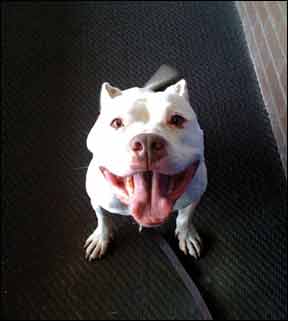
Photo by Rob Bartlett
288
Stories of breed discrimination by insurance companies (and rental property owners) abound as insurance companies increasingly refuse to write homeowner’s and renter’s policies for people who own breeds of dogs that the insurance industry considers to be “dangerous.” Many opponents argue that the industry’s decisions are based on faulty assumptions and improper use of dog bite statistics. Authors of scientific studies on dog bites have argued against the use of their data to support breed-based decision-making by insurers and legislatures. Major veterinary and breed registry organizations have also strongly opposed breed discrimination in insurance. None of these expert opinions seem to dissuade the insurance industry, however.
A Triple Whammy
When Sullivan embarked upon a search to find rental housing in Orlando that would accept her and her dogs, she prepared resumes for her dogs, wrote letters explaining that she would be more than happy to provide liability insurance through a renters’ policy that would cover the dogs, that she’d pay extra deposits, provide stellar references, and Canine Good Citizen (CGC) and Temperament Testing certificates.
That strategy seemed to work – at first. She soon discovered that although she might find a suitable home to rent, the insurance policy of the home’s owner would not allow for Sullivan’s dogs to be on the premises. It took Sullivan “a couple of months of searching and worrying and being rejected by, literally, dozens of agents and private homeowners” before she found a great landlord who had a State Farm policy and allowed her to have her dogs live with her in the house.
It turns out that Sullivan’s dogs were not the only factor that made it difficult for her to find an insurance provider. Sullivan learned that national insurance carriers had been leaving the state of Florida in droves, declining to renew – never mind issuing – policies due to high risk associated with Florida’s hurricanes. Her choices were already limited by her choice of moving to Florida, and her choice in dogs made the task even more difficult!
Insurance Landscape
Homeowner’s and renter’s insurance are categorized by what the industry calls “cause of loss.” These are property damage (fire, lightning, and debris removal; wind and hail; water damage and freezing; theft; all other) and liability (bodily injury and property damage; medical payments and other; credit card and other). Dog bites are in the latter category.
States are responsible for crafting laws that regulate insurers within their borders, and in no state is it mandatory that coverage be offered to every consumer who applies.
The problem is this: Many insurers base their decisions to cover renting or home-owning dog owners solely on the breed of the dogs, not the individual characteristics of the applicants’ dogs. The insurance industry has prejudged entire breeds of dogs as being too risky. And few states have laws that compel insurers to write policies for all dog owners.
When it comes to insuring homeowners or renters with dogs, a few insurance companies consider each applicant on a case-by-case basis that includes the dog’s history — querying the home owner as to whether the dog has a bite history (this is the case with my insurer, USAA). Others, however, maintain that their decisions are based upon their experience with claims for a certain breed, taken from their own database of the number of claims for dog bites and dog attacks per breed. Some base their decisions on lists of dogs considered to be dangerous; others cite published reports on the frequency of dog bites for certain breeds.
The Insurance Information Institute reports that, “Insurers generally oppose legislation that would require changes to their dog breed practices. They contend that government public health studies and the industry’s claims histories show that some breeds are more dangerous than others and are higher loss risks.”
When I inquired with the states of Florida and Georgia, I received similar replies: It’s legal for insurance companies to decline to offer coverage to individuals who own certain breeds of dogs or other animals that are considered aggressive. This seems to be the case across most of the U.S., although a few more forward-thinking states have passed laws that prohibit insurers from discriminating against dog owners based only on breed (Michigan and Pennsylvania, for example).
Valid Rationale?
It’s true that dogs bite. According to the Centers for Disease Control and Prevention, more than 4.7 million people are bitten by dogs annually, resulting in an estimated 800,000 injuries that require medical attention. Information from a December 2010 report from the Agency for Healthcare Research and Quality shows that in 2008, 9,500 Americans received “serious” dog bites. Treating patients admitted to a hospital for dog bites cost hospitals an average of $18,200 per patient and $54 million overall. The report also claims that over a 15-year period, hospitalizations for dog bites increased 100 percent.
The Insurance Information Institute reports that dog bites account for more than one-third of all homeowners’ insurance liability claims, and that the total cost of the dog bite-related claims was about $412 million in 2009. It reports that the average cost of dog bite claims was $24,840 in 2009, while the number of claims increased 4.8 percent to 16,586.
Four hundred and twelve million sounds like a lot of money, but let’s put it into perspective. Property damage accounts for about 96 percent of all claims, with liability claims accounting for the remaining 4 percent of claims – and dog bites accounting for a bit more than a third of liability claims.
Even if we assume the insurance industry has a grasp on dog bite numbers, the statistics they lack are reliable reports of bites by breed, which is a story in itself due to concerns about breed misidentification.
Two published reports seem to serve as the basis for breed discrimination related to dog bites by insurance companies. The first was a 1997 report, “Dog-Bite-Related Fatalities – United States, 1995-1996,” published in the Centers for Disease Control’s (CDC) weekly “Morbidity and Mortality Report.” Authors of this report analyzed data from the Humane Society of the United States (HSUS) and media accounts of dog-bite-related fatalities in the NEXIS database.
The second report is “Breeds of Dogs Involved in Fatal Human Attacks in the United States between 1970 and 1998,” published in the Journal of the American Veterinary Medical Association (JAVMA) in 2000. Its authors also analyzed data from HSUS and media accounts.
Here’s the interesting thing: Both the CDC and American Veterinary Medical Association (AVMA) concluded that their own analyses cannot be used to infer breed-specific risk for dog bite fatalities, nor to identify specific breeds most likely to bite or kill. The CDC went so far as to stop tracking dog attacks by breed in 1998. Both organizations have further qualified that their reports should not be used for policy-making decisions. Why? Both cited several reasons, including the fact attacks by some breeds seem to be regarded as more news-worthy than other breeds, resulting in a disproportionate number of articles about bites by certain breeds. Another factor cited was that identification of breeds is often subjective. Dog-bite-related fatalities, said the JAVMA study, “may be differentially ascribed to breeds with a reputation for aggression.”
Karen Delise, author of the Pit Bull Placebo and founder/researcher for the National Canine Research Council, notes that the CDC recommends “A Community Approach to Dog Bite Prevention” by the AVMA Task Force on Canine Aggression and Human-Canine Interactions. The CDC says, “Dog bites are a largely preventable public health problem, and adults and children can learn to reduce their chances of being bitten.” Their stance is that public education, not breed bans, will prevent dog bites.
Unfortunately, the CDC and JAVMA studies are still cited by some insurance companies as the basis for their policies to deny coverage to people with certain breeds of dogs.
Between a Rock and a Hard Place
If you are a homeowner with a mortgage, your mortgage company requires that you have insurance. Many landlords require their tenants to have a renter’s insurance policy. You are not required to have liability insurance if you own your home outright or your landlord does not require it, but going without insurance leaves you open to significant liability. The website Dog Bite Law advises that “Every dog owner needs to have homeowner’s insurance or renter’s insurance that (a) provides coverage for, and does not exclude, injuries inflicted by dogs or animals in general, and (b) has a limit of at least $100,000 for personal liability.”
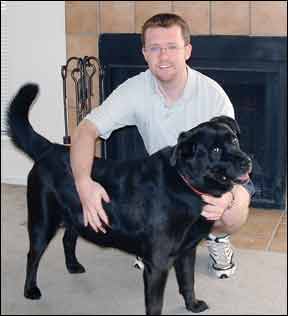
bartlettimage.com
288
Attorney Larry Cunningham, Assistant Dean for Students and assistant professor of legal writing at St. John’s University School of Law in New York, had firsthand experience with breed discrimination in Lubbock, Texas, when he went to buy a home and sought to purchase homeowner’s insurance to cover him and his two dogs, a Rottweiler and a Chow-mix. As a result of his eye-opening experience, he penned an informative piece, “The Case Against Dog Breed Discrimination by Homeowners’ Insurance Companies.”
Cunningham is clear on one point: You must not lie about your status as a dog owner when applying for insurance. “Consumers should definitely shop around, since there are a few companies who will consider an individual family’s circumstances and whether the family dog has a bite history. Above all else, however, families should not lie. Lying on an insurance application is a felony in most states (‘insurance fraud’) and can invalidate the policy later on if there is a claim.”
The American Kennel Club (AKC) is against breed discrimination by insurance companies, stating, “If a dog is a well-behaved member of the household and the community, there is no reason to deny or cancel coverage. In fact, insurance companies should consider a dog an asset, a natural alarm system whose bark may deter intruders and prevent potential theft.” Below are some of the tips they offer to dog owners on how to find homeowner’s insurance (from the online AKC Homeowners’ Insurance Resource Center):
–Ask your dog-owner friends who they use for insurance; if your dog is a purebred, check with your dog’s national breed club for ideas. I’d add to this: also check with local breed and training clubs, and other local dog resources such as dog daycare centers and trainers.
–Contact your state’s insurance commissioner to get a list of the insurance companies doing business there. Tell the commissioner of your frustration over companies’ discriminatory practices. The AKC recommends that, if you have had a policy cancellation or refusal to renew, ask the commissioner to review your policy. Remember, laws might exist, such as in Pennsylvania or Michigan, that prohibit insurance companies from discriminating by breed.
–Agents within the same company may have different policies. Talk to more than one representative for a particular carrier before giving up.
–Contact your state senator or representative and let him or her know the difficulties you are having. Ask that she introduce legislation prohibiting insurance companies from discriminating against homeowners based on the breed of dog they own. (Note: The AKC’s Government Relations Department has materials to help with this.)
–Provide proof that your dog has been trained, and/or has his CGC.
–Consider buying a separate liability policy or separate rider to your existing policy that is specifically directed toward your dogs.
Erin Sullivan’s solution was to get an umbrella policy tied to her car insurance policy that offers liability insurance and covers the dogs. Unfortunately, she could not find any rental policies or homeowner’s policies that would insure her. She says, “At this moment, I do not have any renter’s insurance; no one down here in Florida will write a policy for my dogs, except Citizens (Property Insurance Corporation). And it would only exclude the dogs; it would not cover them.”
In Cunningham’s case, after weeks of calling nearly every insurance agent in Lubbock, he obtained insurance through the Texas Farm Bureau, an organization that he says “advocates for farmers and farming issues.”
I queried other individuals in similar situations; there are those who have foregone insurance; others have lied about their dogs; one built her own home after being asked to leave her rental apartment and also finding restrictions from some neighborhood associations; and one is paying an additional $1,200 a year for a policy that has no breed restrictions.
The Stark Reality
Doggone Safe is a nonprofit organization dedicated to dog bite prevention through education and dog bite victim support. Co-founder and President Joan Orr says, “We think that the history and characteristics of the individual dog and the owner characteristics should be considered rather than the breed. This is difficult for insurance companies since they base everything on statistics and the stats indicate that certain breeds bite more.
“This does not take many other important variables into account, but I am not sure how else they could do it. Teenage and young adult males pay huge car insurance premiums (three or more times what females pay) because statistically they get into more accidents. This is not fair on the boys that are safe and cautious, but it is the way insurance risk assessment works.”
I asked Dean Cunningham what would be needed to convince state insurance regulators to step in and push through changes that would help dog owners. “State legislatures step in when there is political support behind particular regulation,” he says. “For example, in the mid-1990s, it came to light that new mothers were being discharged from hospitals within 12-24 hours of giving birth because the insurance companies were not paying for longer stays. State legislatures stepped in and required insurance companies to pay for at least 48 hours. There was a political uproar that supported the legislative change. I’m not sure the same political pressure exists with the breed discrimination issue.”
Lisa Rodier shares her home with her husband and senior Bouvier, Jolie.



